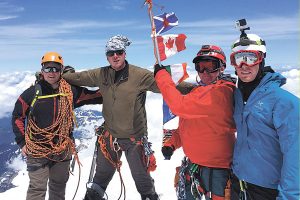Adventure training goes to new heights
By Lookout on Aug 10, 2016 with Comments 0

Canadian Scottish Regiment (Princess Mary’s) Summit team at the top of Mt Baker: Pte Geoff Baldwin, Cpl Erik Carveth, MCpl Denis Byrne and Seth Goodwin from the Langford Fire Department.
MCpl Denis Byrne, Canadian Scottish Regiment ~
One day after Canada Day three soldiers from the Canadian Scottish Regiment, and a volunteer firefighter from Langford Fire department, stood atop Mt Baker, Washington, and gazed across the landscape.
In 27 hours they had climbed 3,286 metres (10,781 feet ) on one of the most heavily glaciated of the Cascade Range volcanoes. Mt Baker, located in the Cascade Mountain range, was formed by massive tectonic plate movements and upheavals deep in the Earth’s crust. It is covered in snow and ice all year. It is the third highest mountain in Washington State and the fifth highest in the Cascade Range.
The Summit Team was led by myself, MCpl Denis Byrne, 53. I am a mountaineering enthusiast and have climbed for over 20 years, with two other successful ascents of Mt Baker, and two of Mt Rainier. I have also scaled Mt Kilimanjaro in East Africa, and have made an attempt on Mt Denali (formerly Mt McKinley) in 2006.
Accompanying me were Cpl Erik Carveth, 23, a strong lead technical rock climber and mountaineer who climbs locally. He has summitted many Vancouver Island peaks, notably Kings Peak at 2,065m (6,775 ft).
The third Canadian Scottish Regiment soldier was Pte Geoff Baldwin, 23, who has some technical rock climbing skills and general mountaineering.
The final member of the team was Seth Goodwin, 23, a volunteer firefighter with the City of Langford. He is a recreational climber and is trained in rope rescue. He is also a primary care Paramedic.
We arrived at the 5,000 foot base camp on June 30 after travelling from Victoria. For 24 hours we practiced self-arrest and crevasse rescue drills, something we had trained for in Squamish two weeks earlier with Sgt (Ret’d) Jason Budd.
The summit did not come easily.
We departed base camp at 1 a.m. on July 2 and climbed throughout the night with headlamps illuminating the route. As we approached the Roman Wall, the 1,500 ft 40 degree crux of the route, hydration at altitude became a pressing issue. Even though it was getting late in the day, we were determined to get to the summit as the weather window was favourable.
At 1:30 p.m. we took our last step to the top. After a few photos and ear to ear grins, we turned our back to the vista and headed down to the Roman Wall. Accompanying us was a two-person team with guide experience, offering support that was gladly accepted.
We were careful on the descent and used technical mountaineering skills to go down the steep 1,000 ft pitch called the Weeping Wall. At 3:30 p.m. on July 3 we arrived safely to base camp, exhausted.
The Canadian Scottish Regiment like a few other units has good adventure training programs for their soldiers including mountaineering and watersports. Major Eaton, the Deputy Commanding Officer of the unit recently summated Pico De Orizaba, North America’s third highest peak, Mt Arrowsmith and the Black Tusk, all within the last six months.
Mountaineering builds team work and warfighting skills, and when executed correctly gives soldiers, sailors and aviators an experience they will never forget.
I plan on trekking to Everest Base Camp in 2017, and climbing Imja Tse (Island Peak) at 6,189m ASL (20,305ft) in honour of Sgt Mark Salesse, a search and rescue technician who was killed in an avalanche during a climbing training mission in February 2015.
Filed Under: Top Stories
About the Author:





